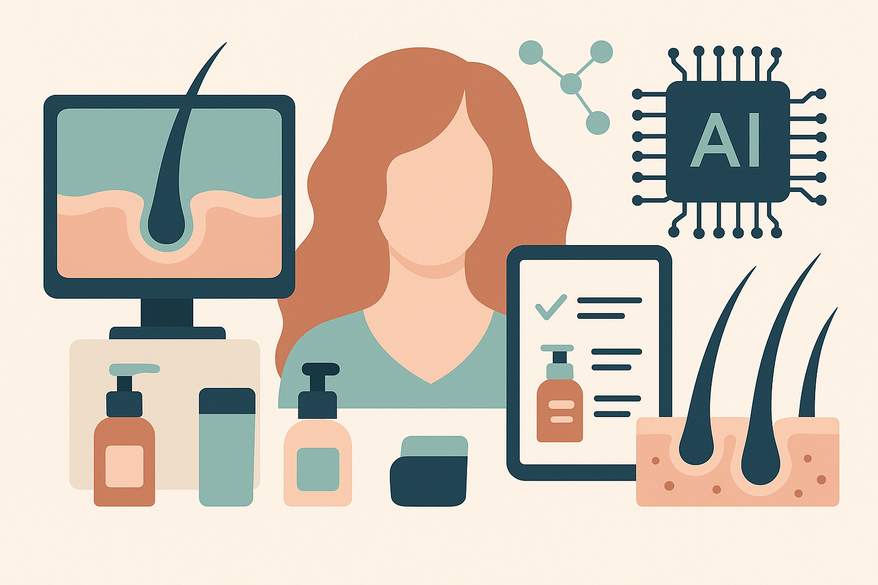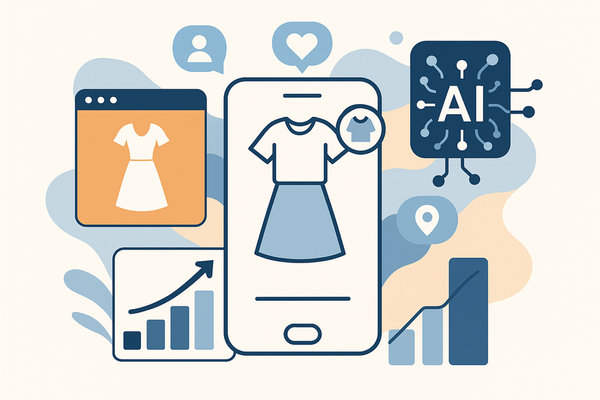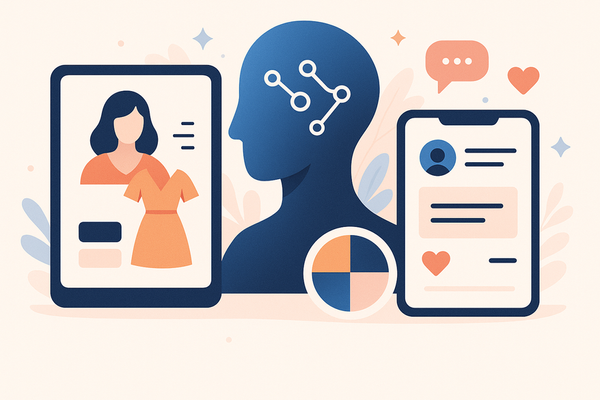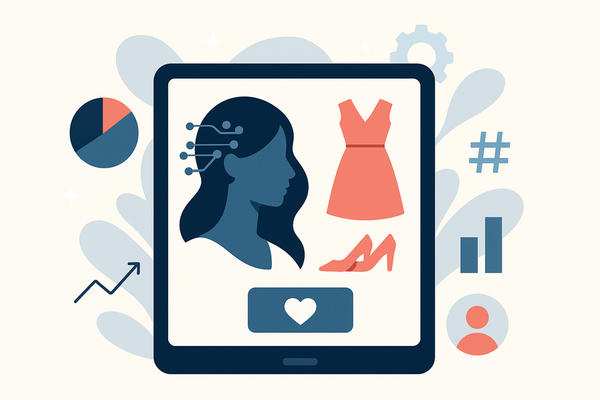How AI Tailors Your Personalized Hair Care Routine AI
Explore how AI revolutionizes personalized hair care routines with tailored diagnostics and recommendations for optimal hair and scalp health.

Estimated reading time: 7 minutes
Key Takeaways
- AI moves beyond one-size-fits-all hair care by analyzing unique hair types, scalp conditions, lifestyles, and environments.
- Data collection methods include questionnaires, at-home sensors, and advanced imaging for precise diagnostics.
- Machine learning algorithms process your data to recommend optimal ingredients, product order, and treatment frequency.
- Personalized routines adapt in real time, offering ongoing optimization and educational insights.
- Future trends point toward genetic integration, IoT devices, bespoke formulations, and continuous learning ecosystems.
Table of Contents
- Section 1: Understanding Personalized Hair Care
- Section 2: How AI Works in Personalized Hair Care
- Section 3: Benefits of Using AI for Personalized Hair Care Routines
- Section 4: Creating Your Personalized Hair Care Routine with AI
- Section 5: Real-life Examples & Case Studies
- Section 6: Future Trends in AI and Hair Care
- Conclusion
- FAQ
Section 1: Understanding Personalized Hair Care
Personalized hair care means building a plan just for you. It blends:
- Your hair type (straight, curly, coarse, fine)
- Scalp health (dry, oily, sensitive)
- Genetics (family history of thinning or dandruff)
- Lifestyle (exercise habits, stress levels)
- Environment (humidity, pollution, sun exposure)
Traditional hair care uses broad categories—you pick a “for dry hair” or “for oily scalp” label and hope it works. This trial and error approach can waste time and money. AI-enhanced techniques use imaging and sensors to diagnose your hair and scalp, then select the best products and routines tailored to you.
Benefits over one-size-fits-all:
- Precision in ingredient choice
- Reduced guesswork
- Faster, noticeable results
Section 2: How AI Works in Personalized Hair Care
Data Collection
- Questionnaires: detailed surveys about your hair history and daily habits.
- At-home sensors: small devices measure moisture, oil, and scalp pH.
- Advanced imaging: high-resolution photos or scans of your scalp and hair.
Analysis & Machine Learning
- Algorithms process your data and compare it with large datasets.
- Patterns emerge showing what ingredients and routines work best for hair like yours.
- The more data it sees, the smarter it gets through deep learning.
Personalized Recommendations
- AI maps analysis to specific ingredients and treatment steps.
- It sets product order, frequency, and special treatments (e.g., scalp mask once a week).
- Real-time updates: if your scalp gets oilier, the routine adapts.
Example Technologies
- K-Scan AI technology: uses imaging plus a database of thousands of hair samples to give precise routines.
- Online AI quizzes/diagnostic apps: get a custom plan within minutes.
- Salon-grade AI diagnostics: in-salon devices measure moisture and oil metrics, then match you to pro products.
Section 3: Benefits of Using AI for Personalized Hair Care Routines
- In-Depth Assessment
Measures hair type, scalp health, genetic factors, and environment for a full picture—no more guessing whether you need protein or moisture. - Data-Driven Accuracy
Science-backed recommendations target thinning, dandruff, dryness, and more. - Efficiency & Convenience
Automated assessments run in the background. You get alerts when your routine needs an update. - Ongoing Optimization
The AI learns from your progress logs, refining your routine over time without manual retesting. - Educational Insights
View data charts of your hair’s progress and understand why certain ingredients work.
Section 4: Creating Your Personalized Hair Care Routine with AI
- Initiate Data Collection
Pick an AI-based tool or app. Enter hair type, scalp condition, lifestyle, and goals. - Participate in Assessments
Complete surveys on habits and concerns. Upload photos or use at-home sensors if available. - Review Your Report
The AI delivers a detailed analysis listing recommended ingredients, products, and steps in order. - Implement, Track & Adjust
Follow the routine as prescribed. Log results—shine, strength, scalp comfort. - Refine with Feedback
Input changes—new goals or environment shifts. AI recalibrates your routine for ongoing improvement.
Section 5: Real-life Examples & Case Studies
Salon AI Diagnostics (K-Scan)
Clients receive detailed scalp images and diagnostics. In-salon and at-home routines align for consistent care. Follow-up scans show improved moisture balance and reduced scalp irritation.
Consumer AI Apps
Case: fine, oily hair user. AI recommended lightweight, sebum-regulating formulas. After three months—less oil, more volume, smoother texture.
Genetic Risk Insights
AI plus genetic testing uncovers thinning predisposition. A proactive regimen of regrowth-stimulating ingredients delays hair loss.
Section 6: Future Trends in AI and Hair Care
- Genetic & Environmental Analytics Integration
AI will blend DNA analysis with daily life data for ultra-precise plans. - IoT Devices at Home
Smart brushes and scalp sensors will sync with AI for live diagnostics. - AI-Powered Ingredient Formulation
Brands will use big data to craft bespoke blends for your profile. - Continuous Learning Ecosystems
As more users join, AI platforms will get smarter, benefiting everyone.
Conclusion
AI-driven personalized hair care routines merge advanced diagnostics, real-time data, and scientific analysis to give you the most precise care possible. You gain faster results, higher accuracy, and a routine that adapts as your hair changes. Next steps: explore top AI-based apps like Best Hair Care App: The Ultimate AI-Powered Hair Health Solution, visit tech-forward salons, or try brands with AI product matching. As AI evolves, bespoke hair health solutions will become ever more accessible, putting perfect hair care in everyone’s hands.
Looking to broaden your AI-driven beauty analysis beyond hair care? Check out Maxx Report for AI-powered reports on looks, transformations, dreams, symbolism, and more.
FAQ
1. What makes AI-based hair care different from traditional routines?
AI uses data-driven diagnostics—imaging, sensors, surveys—to create precise, adaptable regimens, eliminating most of the guesswork inherent in generic products.
2. Do I need special equipment for an AI hair analysis?
Not necessarily. Many apps rely on questionnaires and photos. For deeper insights, at-home sensors or salon-grade devices can be used but aren’t mandatory.
3. How often should I update my AI-driven routine?
Most platforms monitor your progress and suggest tweaks automatically. For best results, log your observations weekly and follow the app’s prompts for routine updates.





